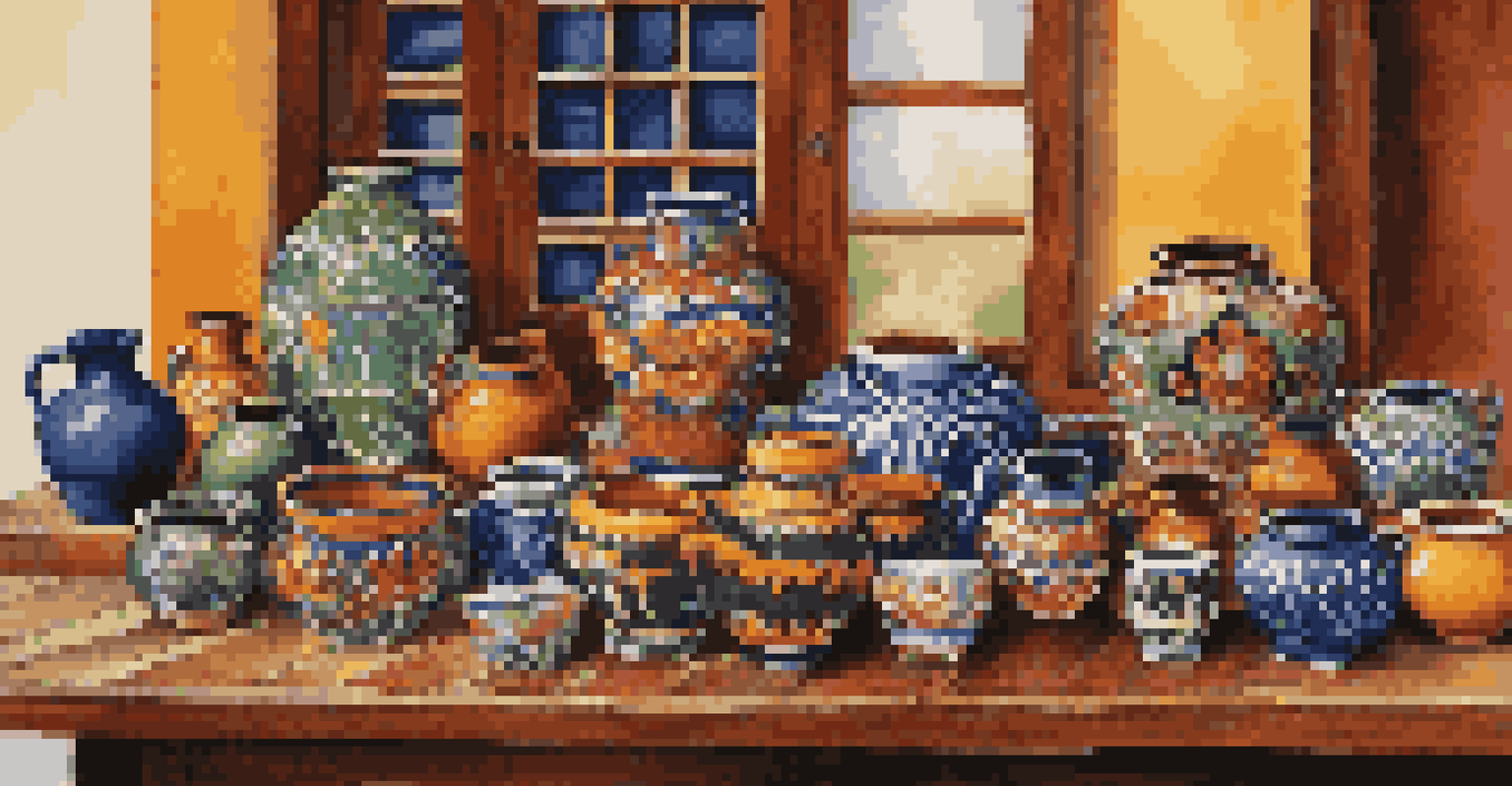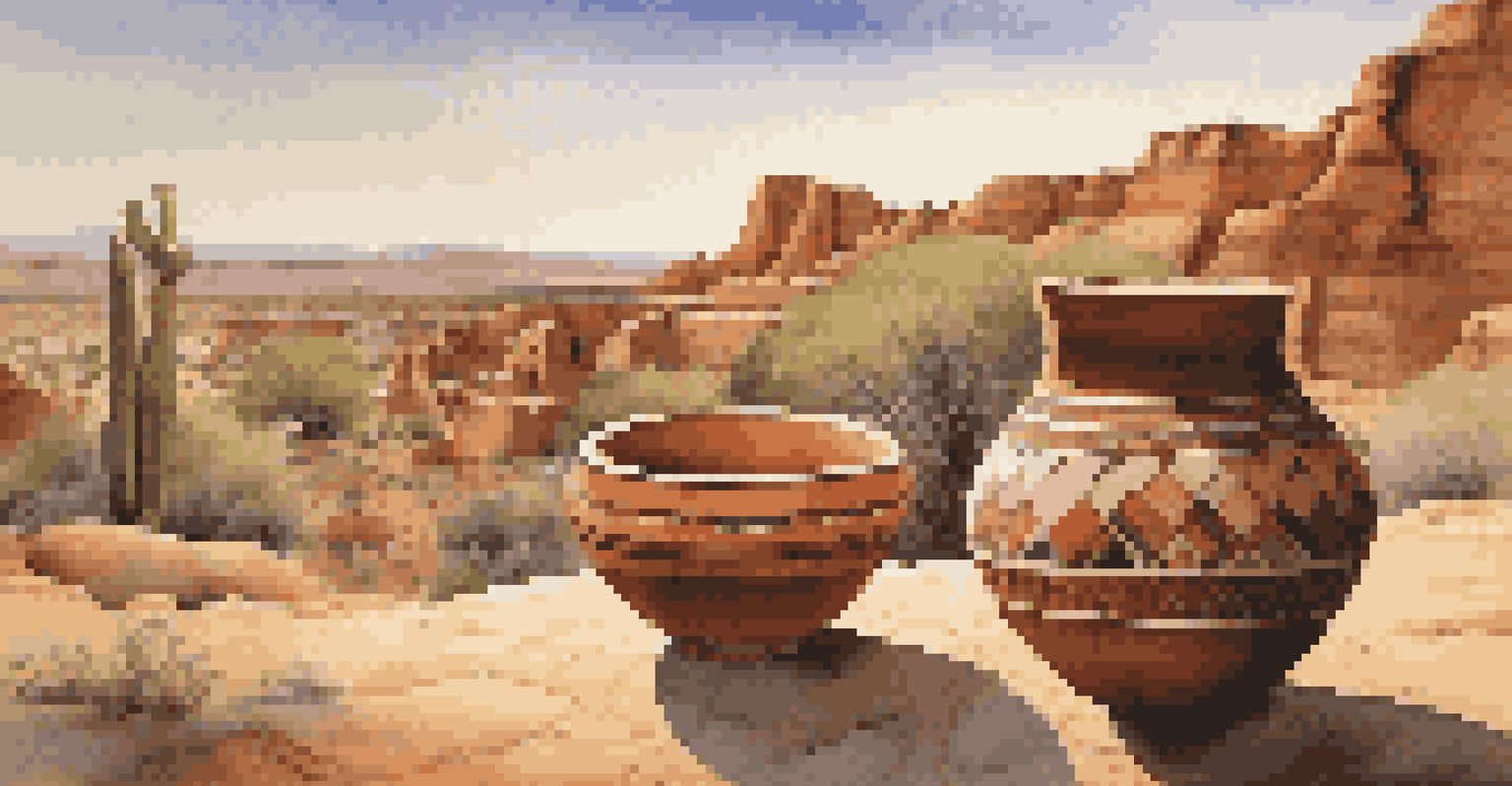Pottery Techniques from Around the World: A Cultural Journey

The Ancient Art of Pottery: A Timeless Tradition
Pottery has been an essential craft for thousands of years, serving as both a functional and artistic outlet. From ancient civilizations to modern artisans, pottery reflects the culture and history of its creators. It’s fascinating to think that the same basic techniques have been passed down through generations, connecting us to our ancestors.
Art is the most beautiful of all lies.
In many cultures, pottery was crucial for daily life, providing vessels for cooking, storage, and serving. The art of shaping clay into beautiful forms has evolved, but the core principles remain the same. This continuity speaks to the universal human need for creativity and expression, bridging gaps between time and space.
As you explore different cultures, you’ll find that pottery is not just about the end product; it’s a reflection of the values and beliefs of a community. Each piece tells a story, whether it’s a simple bowl or an intricate vase, making the world of pottery a rich tapestry of human experience.
Japanese Pottery: Harmony with Nature
Japanese pottery, particularly known for its wabi-sabi aesthetic, beautifully embraces imperfection and simplicity. This philosophy celebrates the beauty found in the natural world, resulting in unique pieces that resonate with their surroundings. The use of local clay and glazes often reflects the environment, making each piece a true representation of its origin.

One of the most renowned styles is Raku, traditionally used in the Japanese tea ceremony. Raku pottery is characterized by its quick firing process and vibrant glazes, creating an intimate connection between the potter and the piece. This technique allows for spontaneous creativity, making each item one-of-a-kind.
Pottery Connects Cultures and History
Pottery serves as a functional and artistic medium that reflects the rich cultural heritage and stories of communities across the globe.
In Japan, pottery is not just an art form; it's a way of life. The process of making pottery encourages mindfulness, patience, and respect for materials, aligning with broader cultural values. This deep connection to nature and tradition is what makes Japanese pottery so revered worldwide.
Mexican Pottery: Vivid Colors and Bold Designs
Mexican pottery is a feast for the eyes, bursting with color and intricate designs that reflect the rich culture of the region. From Talavera tiles to Oaxacan black pottery, each style offers a glimpse into the history and traditions of its people. The vibrant hues often symbolize various aspects of life, from nature to spirituality, making each piece a narrative of its own.
The essence of art is to be a part of the world, to reflect its beauty and complexity.
Artisans in Mexico often use traditional methods passed down through generations, which not only preserves their craft but also their cultural heritage. The process of hand-painting and glazing each piece requires immense skill and dedication, resulting in stunning works of art. This commitment to craftsmanship is evident in the level of detail showcased in every creation.
Moreover, pottery plays a significant role in Mexican celebrations and rituals. Whether it’s a beautifully crafted plate for a family gathering or decorative pieces for festivals, pottery serves as a medium for cultural expression and community bonding. This makes Mexican pottery not just art, but an integral part of life.
Native American Pottery: A Spiritual Connection
Native American pottery is deeply rooted in the spiritual beliefs and traditions of various tribes across North America. Each piece is often imbued with significance, representing cultural stories, rituals, and ancestral heritage. The use of natural materials and designs reflects a profound respect for the earth and its resources.
One notable style is Pueblo pottery, known for its intricate designs and distinctive shapes. Artists often use traditional techniques, such as hand-coiling and natural pigments, to create stunning pieces that are both functional and ceremonial. The act of making pottery is seen as a way to connect with ancestors and the spirit of the land.
Sustainability in Modern Pottery
Contemporary potters are embracing sustainable practices, ensuring the craft's evolution while honoring traditional methods and the environment.
In many Native American cultures, pottery is not just an art form; it's a way of preserving history and identity. Each creation serves as a vessel for storytelling, allowing future generations to understand and appreciate their heritage. This blend of artistry and spirituality makes Native American pottery unique and invaluable.
Italian Ceramics: Tradition Meets Innovation
Italian ceramics are celebrated for their exquisite craftsmanship and vibrant artistry, often characterized by intricate patterns and bright colors. From the famous Deruta pottery to the rustic styles of Sicily, Italian ceramics reflect a rich cultural heritage that combines tradition with innovation. Each piece tells a story of its region, showcasing the unique influences that shape its design.
Artisans often draw inspiration from nature, history, and local legends, resulting in pieces that are as meaningful as they are beautiful. The process of creating Italian ceramics involves meticulous hand-painting and glazing, ensuring that each item is a true work of art. This dedication to quality and detail is what sets Italian ceramics apart in the world of pottery.
Moreover, Italian ceramics play an essential role in daily life, from tableware to decorative items. They are a staple in Italian homes, where the beauty of pottery enhances the dining experience. This blend of functionality and artistry is what makes Italian ceramics beloved both locally and internationally.
African Pottery: A Blend of Function and Art
African pottery is rich in diversity, with each region showcasing unique styles and techniques that reflect its cultural identity. From the geometric patterns of the Zulu to the intricate designs of the Berber, African pottery is a stunning blend of function and art. These pieces are often created for practical use, yet they also serve as an expression of cultural values and beliefs.
In many African communities, pottery is often a communal activity, with women playing a central role in its creation. This collaborative process fosters a sense of unity and shared purpose, as each artisan contributes their skills and creativity. The result is a vibrant tapestry of styles that celebrates both individual and collective artistry.
Artistry Meets Functionality
From ceremonial pieces to everyday tableware, pottery blends artistry with practical use, making it an integral part of cultural expression.
Additionally, African pottery is often adorned with symbolic motifs that convey messages or tell stories. This connection between art and meaning enhances the cultural significance of each piece, making it a vital part of community heritage. As a result, African pottery is not just about aesthetics; it’s a profound representation of identity and history.
Middle Eastern Pottery: Artistry Rooted in Heritage
Middle Eastern pottery is a beautiful reflection of the region's rich history and cultural diversity. From the exquisite Iznik tiles of Turkey to the intricate Persian ceramics, these pieces showcase a mastery of design and craftsmanship. The use of vibrant colors and intricate patterns is not just for decoration; it often carries cultural significance, telling stories of the past.
The techniques used in Middle Eastern pottery are often influenced by centuries of trade and cultural exchange. This has led to a blending of styles, resulting in unique pieces that incorporate elements from various traditions. The artistry involved in creating these ceramics, often using traditional methods, highlights the region's dedication to preserving its heritage.

Moreover, pottery in the Middle East often serves as a functional art form, from serving dishes to decorative tiles. These items play an important role in daily life, bridging the gap between utility and artistry. This connection to cultural practices makes Middle Eastern pottery not just visually stunning but also deeply meaningful.
The Future of Pottery: Blending Tradition with Modernity
As the world evolves, so does the art of pottery. Many contemporary artists are finding innovative ways to blend traditional techniques with modern aesthetics, creating pieces that resonate with today's audience. This fusion not only keeps the ancient craft alive but also allows for new forms of expression that reflect current societal values.
The rise of sustainable practices in pottery is also noteworthy, with many artisans focusing on eco-friendly materials and methods. This shift not only respects the environment but also honors the traditions of pottery-making that are often rooted in a deep connection to the earth. By prioritizing sustainability, modern potters are ensuring that their craft can thrive for future generations.
Ultimately, the future of pottery is about embracing both the past and the present. As artists continue to explore and experiment, they contribute to a vibrant global community that celebrates diversity and creativity. This ongoing evolution of pottery reminds us that art is not static; it is a living expression of culture and humanity.